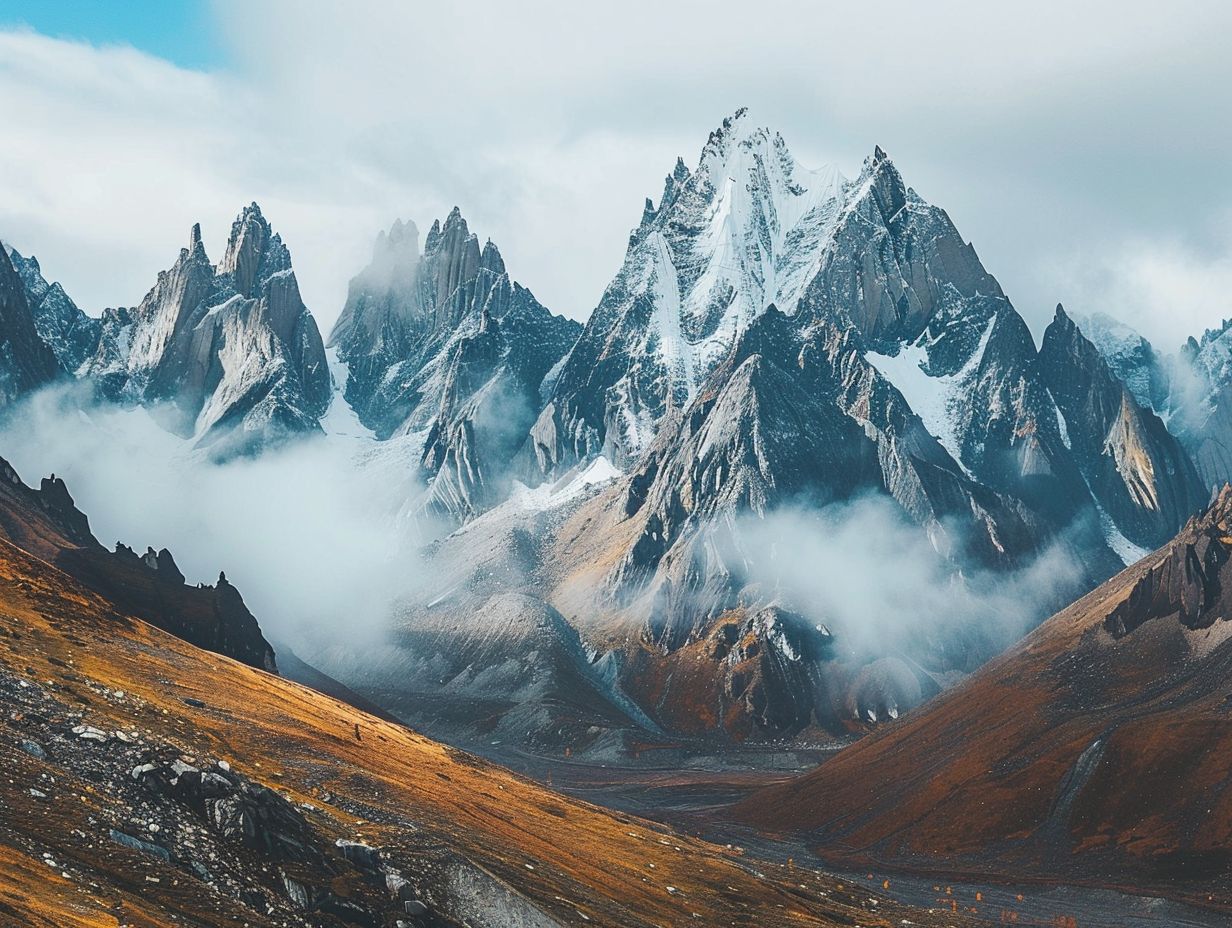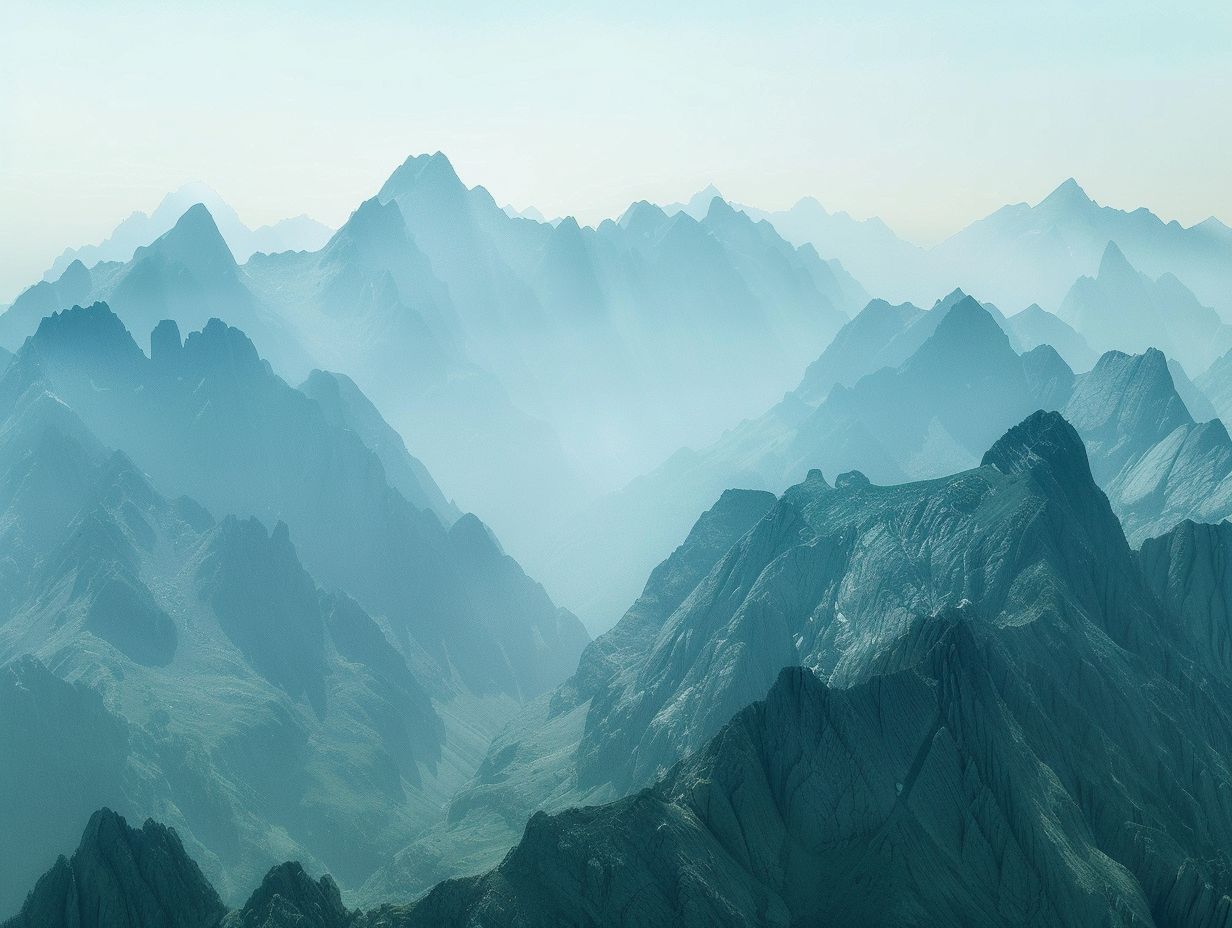
Seven Summits
Have you ever wondered what it takes to conquer the highest peaks on each continent? From the towering Mount Everest in Asia to the remote Puncak Jaya in Oceania, the Seven Summits present a unique challenge for mountaineers around the world.
We will explore the daunting obstacles climbers face, including high altitudes, extreme weather conditions, and technical difficulty. Proper physical training, altitude acclimatization, and mental preparation are essential for success in this ultimate mountaineering challenge.
Join us as we delve into the world of the Seven Summits and discover what it takes to reach the top of the world.
Key Takeaways:
- Climbing the Seven Summits is a major accomplishment for mountaineers, with each peak representing a continent.
- Challenges include high altitude, extreme weather conditions, and technical difficulty.
- Proper physical training, altitude acclimatization, and mental preparation are crucial for a successful climb.
What are the Seven Summits?

The Seven Summits refer to the highest mountains on each of the seven traditional continents, representing a pinnacle of mountaineering achievement for adventurers seeking to conquer these iconic peaks.
Each of the Seven Summits offers a distinct set of challenges and rewards. From the majestic heights of Mount Everest in Asia to the icy remoteness of Antarctica’s Vinson Massif, these peaks demand unwavering determination, skill, and resilience.
1. Mount Everest (Asia)
Mount Everest, located in Asia, stands as the highest peak in the world and is a coveted challenge for climbers worldwide due to its extreme altitude and treacherous conditions.
Over the years, numerous expeditions have attempted to conquer Mount Everest, with the first successful summit achieved by Sir Edmund Hillary and Tenzing Norgay in 1953. This historic accomplishment paved the way for future climbers, inspiring a wave of expeditions aiming to reach the summit. Renowned mountaineers like Reinhold Messner have left their mark on Everest’s history, pushing the limits of human endurance and skill in the quest to conquer the peak.
There are several established routes to the summit, with the South Col route being the most popular. Base camps set up at various altitudes provide essential support for climbers acclimatizing to the high altitude and harsh conditions.
Despite advances in technology and safety measures, climbing Everest remains a perilous endeavor, with risks including altitude sickness, avalanches, and extreme weather posing constant threats to those attempting the ascent.
2. Aconcagua (South America)
Aconcagua, situated in South America, is the highest peak in the Western Hemisphere and presents climbers with a challenging ascent characterized by high altitude and unpredictable weather conditions.
Ascending Aconcagua entails navigating various route options, each offering unique challenges and rewards. The Normal Route, also known as the Northwest Route, is the most popular and relatively straightforward, making it accessible to climbers with varying experience levels.
On the other hand, experienced mountaineers often opt for more technical routes like the Polish Glacier or the Vacas Valley Route, which demand a higher level of technical skill and endurance.
3. Denali (North America)
Denali, located in North America, is renowned for its technical challenges and severe weather conditions, making it a formidable test for mountaineers seeking to conquer one of the Seven Summits.
Standing at 20,310 feet, Denali’s history of climbing dates back to the early 1900s when it was first summited by Hudson Stuck and his team in 1913. The Alaskan mountain offers a unique experience due to its remote location and towering presence.
Climbers must possess advanced navigation skills to navigate the steep, icy slopes and unpredictable storms that are a regular occurrence on North America’s highest peak. William D. Hackett, a legendary climber known for his daring ascents, left an indelible mark on Denali’s mountaineering legacy with his innovative techniques and bold spirit.
4. Kilimanjaro (Africa)

Kilimanjaro, the highest peak in Africa, offers climbers a unique challenge with its non-technical ascent and diverse ecological zones, attracting adventurers from around the globe to experience its breathtaking beauty.
There are several routes to the summit of Kilimanjaro, each varying in difficulty and scenery. The Marangu route, also known as the ‘Coca-Cola’ route, is one of the more popular paths due to its gradual slope and hut accommodations.
In contrast, the Machame route, referred to as the ‘Whiskey’ route, is favored for its stunning views and diverse landscapes, although it is more challenging.
These routes present climbers with a mix of experiences, from dense forests to alpine deserts, before reaching the iconic peak.
5. Mount Elbrus (Europe)
Mount Elbrus, situated in Europe, stands as the highest peak on the continent and presents climbers with a challenging ascent marked by glaciated slopes and unpredictable weather conditions. It’s history is dotted with accomplished expeditions, attracting climbers from around the world.
The technical skills required for conquering Mount Elbrus include ice climbing, crevasse rescue, and high-altitude acclimatization. These essential abilities are crucial for navigating the treacherous terrain effectively.
The allure of scaling Mount Elbrus lies not only in its majestic height but also in the stunning views it offers from the summit. For mountaineers like Rob Hall, reaching the peak represents a supreme achievement, a test of endurance and skill amid the harsh conditions.
6. Vinson Massif (Antarctica)
Vinson Massif, located in Antarctica, marks the highest point on the continent and presents climbers with a remote and challenging expedition to reach its summit, surrounded by the icy wilderness of the southernmost continent.
Climbers who embark on this journey encounter numerous logistical challenges, such as extreme weather conditions, limited infrastructure, and the need for specialized equipment to withstand the harsh environment. The isolation of Antarctica adds another layer of complexity, with limited access to medical facilities and communication resources.
Renowned guides like Ryan Waters bring their expertise to lead expeditions, navigating treacherous terrain and ensuring the safety of climbers amidst the vast and pristine landscape of this unique continent.
7. Puncak Jaya (Oceania)
Puncak Jaya, located in Oceania, represents a unique challenge for climbers as the highest peak in Australasia, requiring technical skills and perseverance to navigate its steep slopes and challenging conditions.
Ascending Puncak Jaya is not only a physical feat but also a journey that encapsulates the cultural significance of the region. The peak holds deep spiritual meaning for the indigenous communities, with its name translating to ‘Victory Peak.’
Climbers who undertake the ascent not only test their physical limits but also immerse themselves in the rich heritage of the land.
Notable climbers like Gary Ball have left their mark on Puncak Jaya, inspiring others to follow in their footsteps. Ball’s triumph over the peak serves as a beacon of determination and courage, motivating aspiring climbers to take on this formidable challenge.
What are the Challenges of Climbing the Seven Summits?

Climbing the Seven Summits presents mountaineers with a series of formidable challenges, from navigating high altitudes and extreme weather conditions to overcoming technical difficulties along the ascent of each peak.
One of the most significant hurdles climbers face is the physiological strain exerted by the high altitude environments, where oxygen levels are substantially lower, leading to altitude sickness and fatigue. This demands exceptional physical fitness and mental resilience to cope with the effects of hypoxia on the body.
The unpredictable and harsh weather conditions on these peaks pose a constant threat, requiring climbers to be prepared for severe cold, high winds, and sudden storms that can endanger their safety.
1. High Altitude
One of the primary challenges of climbing the Seven Summits is the high altitude, which poses risks of altitude sickness and physical exhaustion, requiring climbers to acclimatize effectively to ensure a successful ascent.
As climbers ascend to higher altitudes, the air becomes thinner, making it difficult for the body to obtain an adequate oxygen supply, leading to symptoms of headache, nausea, and fatigue. These altitude-related challenges are not only physically demanding but can also impact cognitive functions and decision-making abilities, crucial for safe mountain climbing.
Acclimatization strategies such as gradual altitude gain, staying properly hydrated, and adequate rest play a vital role in helping climbers adapt to the harsh conditions. Without proper acclimatization, the risks of developing severe altitude sickness, HAPE (High Altitude Pulmonary Edema), or HACE (High Altitude Cerebral Edema) significantly increase, jeopardizing the success of summit attempts.
2. Extreme Weather Conditions
Navigating the Seven Summits involves encountering a range of extreme weather conditions, from blizzards and high winds to freezing temperatures, adding an element of unpredictability and danger to each climb.
Mountaineering expeditions can be heavily impacted by the unpredictable nature of weather patterns, especially on different peaks across the world. For instance, climbers tackling the notorious K2 face fierce winds and avalanches due to its steep slopes, while those on Aconcagua battle with extreme cold temperatures and sudden storms.
The challenges posed by varying weather patterns require climbers to be equipped with critical gear such as insulated clothing, crampons, and high-altitude tents to withstand harsh conditions.
Preparation is key as conditions can rapidly change during expeditions, making it essential to carry extra supplies and plan meticulously.
3. Technical Difficulty
Climbing the Seven Summits involves overcoming technical difficulties such as steep rock faces, icy slopes, and crevassed terrain, requiring climbers to possess advanced mountaineering skills and expertise to navigate safely.
Expedition of the Seven Summits presents unique challenges on each peak, from the technical demands of rock climbing on Aconcagua to the treacherous ice climbing of Mount Everest. These diverse terrains demand different sets of specialized skills, from ice axe techniques to rock anchor placements.
For instance, seasoned mountaineers who conquered Mount Kosciuszko, the shortest of the Seven Summits, emphasize the importance of route finding in rocky areas, where following the correct path is crucial for safety and efficiency.
How Can One Prepare for Climbing the Seven Summits?

Preparing for the challenge of climbing the Seven Summits requires a comprehensive approach that includes physical training, altitude acclimatization, proper gear and equipment, and mental preparation to tackle the demanding conditions of each peak.
From rigorous training regimes to careful gear selection and mental fortitude, climbers must equip themselves comprehensively for the challenges ahead. In this detailed section, we’ll explore the key components of Seven Summits preparation, covering physical conditioning, altitude acclimatization, gear essentials, and mental readiness:
1. Physical Training
Physical training plays a crucial role in preparing for the Seven Summits, as climbers need to build strength, endurance, and cardiovascular fitness to withstand the rigors of high-altitude climbs and extended expeditions.
- Strength training is a key component of a climber’s regimen, focusing on exercises that target muscle groups essential for the demands of mountain climbing. Plus weightlifting, climbers often incorporate bodyweight exercises such as pull-ups, push-ups, and planks to enhance overall strength and stability.
- Aerobic conditioning is equally important, with activities like running, cycling, and swimming helping climbers improve their cardiovascular fitness and oxygen utilization. Outdoor practice hikes are crucial to simulate the terrain and conditions climbers will face during the actual Seven Summits expeditions.
2. Altitude Acclimatization
Altitude acclimatization is essential for climbers preparing to tackle the Seven Summits, as gradual exposure to high elevations helps the body adjust to lower oxygen levels and reduces the risk of altitude sickness during ascents.
Successful climbers, like Denali summiteers, often employ strategic methods to aid in altitude acclimatization. This can include a progressive ascent approach, allowing time for the body to adapt to changing conditions.
Climbers may also use supplemental oxygen, specialized gear, and dietary adjustments to support their bodies at higher altitudes. Pacing climbs is crucial in acclimatization, ensuring that the body has enough time to adjust to the reduced oxygen levels and prevent altitude-related illnesses like HAPE and HACE.
3. Proper Gear and Equipment
Having the right gear and equipment is crucial for climbers embarking on the Seven Summits, as specialized clothing, footwear, technical gear, and safety equipment are essential for navigating the challenging terrain and weather conditions.
- For climbing these majestic peaks, layered clothing to combat the fluctuating temperatures is a must-have.
- Think moisture-wicking base layers, insulating mid-layers, and a waterproof outer shell.
- Your choice of mountaineering boots is critical; they need to be sturdy, crampon-compatible, and insulated.
- Investing in a high-quality ice axe for self-arrest and climbing support can be a game-changer.
- A reliable harness and proper safety gear like helmets, ropes, and carabiners are non-negotiables for safeguarding against falls and ensuring secure belays.
4. Mental Preparation
Mental preparation is key for climbers facing the challenges of the Seven Summits, as resilience, determination, and mental fortitude are essential for overcoming adversity, uncertainty, and the physical demands of high-altitude expeditions.
Focus is crucial when navigating treacherous terrains such as the steep slopes of Mount Everest or the icy cliffs of Denali. Climbers must train both their bodies and minds for the immense physical and psychological hurdles they will encounter.
Strategies like visualization techniques, positive self-talk, and setting small achievable goals help climbers stay motivated and maintain their mental strength throughout the climb. Learning to manage stress, utilize breathing exercises, and recognize signs of fatigue are vital tools for sustaining energy and focus during long and arduous ascents.
Frequently Asked Questions:
1. What are the Seven Summits?
A: The Seven Summits refer to the highest mountains on each of the seven traditional continents, including Mount Everest, Aconcagua, Denali, Kilimanjaro, Elbrus, Vinson Massif, and Carstensz Pyramid.
2. Who was the first person to climb the Seven Summits?
A: Richard Bass became the first climber to reach the peak of the Seven Summits on April 30th, 1985.
3. How long does it take to climb the Seven Summits?
A: The time it takes to climb the Seven Summits varies depending on the individual’s experience and physical abilities. On average, it takes 3-4 years for experienced climbers to complete the challenge.
4. Which is the highest of the Seven Summits?
A: Mount Everest, standing at 8,848 meters (29,029 ft), is the highest of the Seven Summits and is located in the Himalayas on the border between Nepal and Tibet.
5. How many people have climbed the Seven Summits?
A: As of 2021, over 500 people have successfully climbed the Seven Summits, with the majority of them being experienced mountaineers.
6. Are there alternative lists of the Seven Summits?
A: Yes, there are alternative lists of the Seven Summits, such as the Messner list which includes Mount Kosciuszko in Australia instead of Carstensz Pyramid in Indonesia. However, the traditional Seven Summits list is the most widely recognized and accepted.